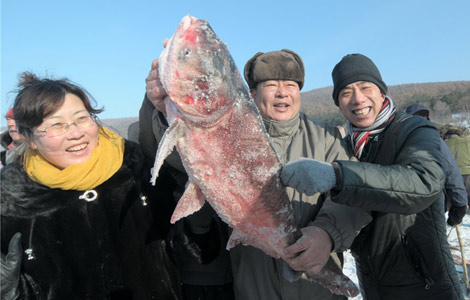Japan's homeless recruited for murky Fukushima clean-up
Updated: 2013-12-30 09:37
(Agencies)
|
||||||||
SENDAI, Japan - Seiji Sasa hits the train station in this northern Japanese city before dawn most mornings to prowl for homeless men.
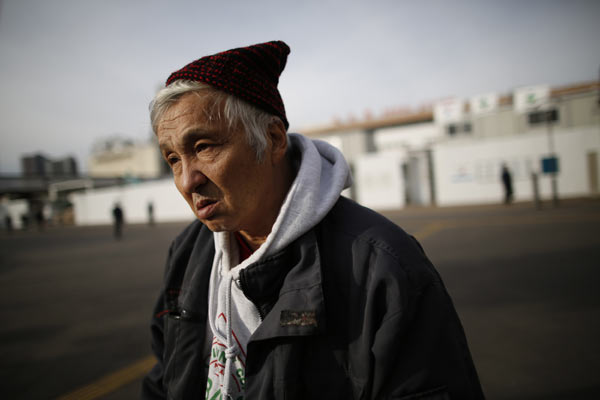 |
|
Shizuya Nishiyama, a 57-year-old homeless man from Hokkaido, speaks during an interview with Reuters at Sendai Station in Sendai, northern Japan December 18, 2013. [Photo/Agencies] |
He isn't a social worker. He's a recruiter. The men in Sendai Station are potential laborers that Sasa can dispatch to contractors in Japan's nuclear disaster zone for a bounty of $100 a head.
"This is how labor recruiters like me come in every day," Sasa says, as he strides past men sleeping on cardboard and clutching at their coats against the early winter cold.
It's also how Japan finds people willing to accept minimum wage for one of the most undesirable jobs in the industrialized world: working on the $35 billion, taxpayer-funded effort to clean up radioactive fallout across an area of northern Japan larger than Hong Kong.
Almost three years ago, a massive earthquake and tsunami leveled villages across Japan's northeast coast and set off multiple meltdowns at the Fukushima nuclear plant. Today, the most ambitious radiation clean-up ever attempted is running behind schedule. The effort is being dogged by both a lack of oversight and a shortage of workers, according to a Reuters analysis of contracts and interviews with dozens of those involved.
In January, October and November, Japanese gangsters were arrested on charges of infiltrating construction giant Obayashi Corp's network of decontamination subcontractors and illegally sending workers to the government-funded project.
In the October case, homeless men were rounded up at Sendai's train station by Sasa, then put to work clearing radioactive soil and debris in Fukushima City for less than minimum wage, according to police and accounts of those involved. The men reported up through a chain of three other companies to Obayashi, Japan's second-largest construction company.
Obayashi, which is one of more than 20 major contractors involved in government-funded radiation removal projects, has not been accused of any wrongdoing. But the spate of arrests has shown that members of Japan's three largest criminal syndicates - Yamaguchi-gumi, Sumiyoshi-kai and Inagawa-kai - had set up black-market recruiting agencies under Obayashi.
"We are taking it very seriously that these incidents keep happening one after another," said Junichi Ichikawa, a spokesman for Obayashi. He said the company tightened its scrutiny of its lower-tier subcontractors in order to shut out gangsters, known as the yakuza. "There were elements of what we had been doing that did not go far enough."
OVERSIGHT LEFT TO TOP CONTRACTORS
Part of the problem in monitoring taxpayer money in Fukushima is the sheer number of companies involved in decontamination, extending from the major contractors at the top to tiny subcontractors many layers below them. The total number has not been announced. But in the 10 most contaminated towns and a highway that runs north past the gates of the wrecked plant in Fukushima, Reuters found 733 companies were performing work for the Ministry of Environment, according to partial contract terms released by the ministry in August under Japan's information disclosure law.
Reuters found 56 subcontractors listed on environment ministry contracts worth a total of $2.5 billion in the most radiated areas of Fukushima that would have been barred from traditional public works because they had not been vetted by the construction ministry.
The 2011 law that regulates decontamination put control under the environment ministry, the largest spending program ever managed by the 10-year-old agency. The same law also effectively loosened controls on bidders, making it possible for firms to win radiation removal contracts without the basic disclosure and certification required for participating in public works such as road construction.
Reuters also found five firms working for the Ministry of Environment that could not be identified. They had no construction ministry registration, no listed phone number or website, and Reuters could not find a basic corporate registration disclosing ownership. There was also no record of the firms in the database of Japan's largest credit research firm, Teikoku Databank.
"As a general matter, in cases like this, we would have to start by looking at whether a company like this is real," said Shigenobu Abe, a researcher at Teikoku Databank. "After that, it would be necessary to look at whether this is an active company and at the background of its executive and directors."
Responsibility for monitoring the hiring, safety records and suitability of hundreds of small firms involved in Fukushima's decontamination rests with the top contractors, including Kajima Corp, Taisei Corp and Shimizu Corp, officials said.
"In reality, major contractors manage each work site," said Hide Motonaga, deputy director of the radiation clean-up division of the environment ministry.
But, as a practical matter, many of the construction companies involved in the clean-up say it is impossible to monitor what is happening on the ground because of the multiple layers of contracts for each job that keep the top contractors removed from those doing the work.
"If you started looking at every single person, the project wouldn't move forward. You wouldn't get a tenth of the people you need," said Yukio Suganuma, president of Aisogo Service, a construction company that was hired in 2012 to clean up radioactive fallout from streets in the town of Tamura.
The sprawl of small firms working in Fukushima is an unintended consequence of Japan's legacy of tight labor-market regulations combined with the aging population's deepening shortage of workers. Japan's construction companies cannot afford to keep a large payroll and dispatching temporary workers to construction sites is prohibited. As a result, smaller firms step into the gap, promising workers in exchange for a cut of their wages.
Below these official subcontractors, a shadowy network of gangsters and illegal brokers who hire homeless men has also become active in Fukushima. Ministry of Environment contracts in the most radioactive areas of Fukushima prefecture are particularly lucrative because the government pays an additional $100 in hazard allowance per day for each worker.
Takayoshi Igarashi, a lawyer and professor at Hosei University, said the initial rush to find companies for decontamination was understandable in the immediate aftermath of the disaster when the priority was emergency response. But he said the government now needs to tighten its scrutiny to prevent a range of abuses, including bid rigging.
"There are many unknown entities getting involved in decontamination projects," said Igarashi, a former advisor to ex-Prime Minister Naoto Kan. "There needs to be a thorough check on what companies are working on what, and when. I think it's probably completely lawless if the top contractors are not thoroughly checking."
The Ministry of Environment announced on Thursday that work on the most contaminated sites would take two to three years longer than the original March 2014 deadline. That means many of the more than 60,000 who lived in the area before the disaster will remain unable to return home until six years after the disaster.
Earlier this month, Abe, who pledged his government would "take full responsibility for the rebirth of Fukushima" boosted the budget for decontamination to $35 billion, including funds to create a facility to store radioactive soil and other waste near the wrecked nuclear plant.
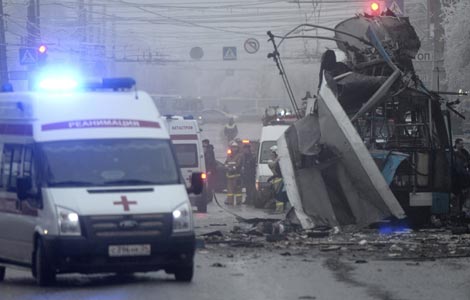
 Second blast kills 10 in Russian city
Second blast kills 10 in Russian city
 F1 legend Schumacher in coma after ski accident
F1 legend Schumacher in coma after ski accident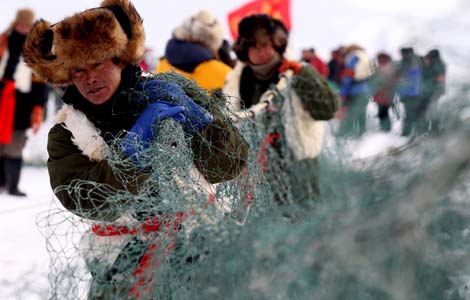
 Net result
Net result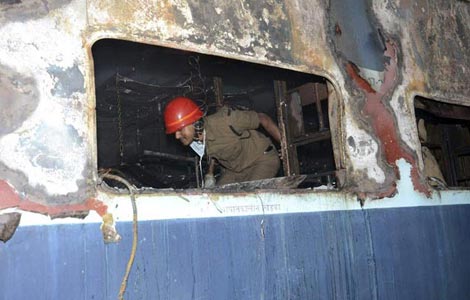
 Fire on express train in India kills at least 26
Fire on express train in India kills at least 26
 Times Square visitors purge bad memories
Times Square visitors purge bad memories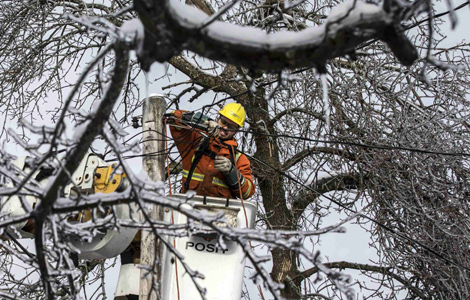
 Ice storm leaves many without power in US, Canada
Ice storm leaves many without power in US, Canada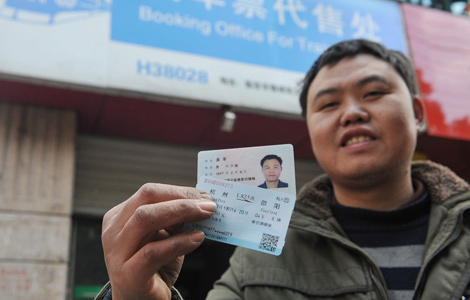
 'Chunyun' train tickets up for sale
'Chunyun' train tickets up for sale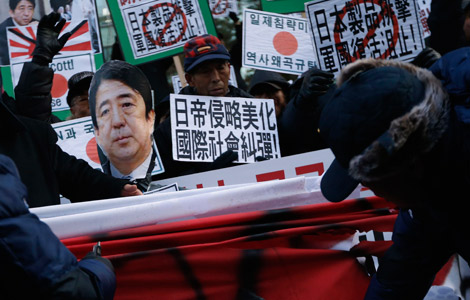
 Abe's war shrine visit sparks protest
Abe's war shrine visit sparks protest
Most Viewed
Editor's Picks

|

|

|

|

|

|
Today's Top News
Outrage still festers over Abe shrine visit
Suicide bomber kills 16 at Russian train station
Magazine reveals NSA hacking tactics
Pentagon chief concerned over Egypt
Broader auto future for China, US
Li says economy stable in 2014
Bigger role considered in the Arctic
3rd high-level official probed
US Weekly

|

|


